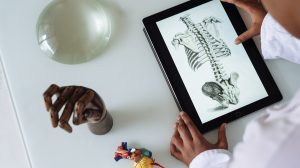
Class Name
AMH 4680 Women in American Science
Instructor
Amy Foster
When is it offered?
Every spring, usually
How many students are in a class?
Between 20–40
Prerequisites
AMH 2010/2020 are expected
From the Professor
How would you describe the Women in Science course?
The Women in Science course looks at the history of American and European women who have pursued scientific endeavors from the 19th century forward. That isn’t to say that there weren’t women contributing to scientific discovery before then; there most definitely were. But part of what started to change in the 19th century was women’s access to an education in those fields. As more schools and universities opened their doors to female students, it became possible for women to earn a degree in these fields instead of just learning from their fathers, and along side their brothers and husbands. We explore these early experiences and struggles to gain further access to opportunities and careers in science, engineering, and medicine.
Why should students take the course?
The last 30 years have witnessed a big push to encourage girls and women to participate in STEM. In History classes, we have taught our students about women’s history and women’s contributions to the workplace. But ask people to name a female scientist and still the only name that comes come to mind for most people is Marie Curie. While that is a name everyone should know, I don’t want it to be the only name people know. One of the reasons that girls and young women don’t stay in STEM is the lack of mentors who look like them. I want my students to leave the course with a greater understanding of the contributions women have made to the sciences for centuries. I think the history of women in science can serve as a reminder that there have been and continue to be trailblazers in the sciences, and that the STEM world is open to anyone.
What do you hope students learn?
As celebratory as I would like the course to be, the truth is that women had to fight to get their opportunities in the sciences. There were some 19th-century scientists who espoused the idea that educating women would limit their ability to have children. We have known for a long time now that isn’t true, but these unrealistic barriers make it challenging for women to get an education in any field. But through determination and stepwise progress, women did break through those barriers, one at a time. One of the biggest challenges for women was fighting against the Madame Curie image. She won two Nobel Prizes during her career. That’s practically unheard of. But others still expected women in the sciences to be like Marie Curie, which is an impossible goal for the vast majority of male scientists! What I see in the women we talk about in the course is not only brilliance, but bravery. I’d like my students to see that as well.
What does the coursework entail?
Even though the topic relates to science, the course is still an upper-division history course. So, we do a lot of reading and thinking about how these historians of science research their subjects and make a strong historical argument. I hope, though, that the discussions we do and the major assignments I have in the course give students some opportunity to explore specific topics in the history of science that interest them.
What inspired your own interest in women in science?
Even though my Ph.D. is in History, my undergraduate degree is in Aeronautical and Astronautical Engineering. As an engineering student, it was impossible to ignore the fact that as a woman in STEM I was an important statistic. As I turned my attention to the study of history, I used the awareness I had as an engineering student to drive my own research. I was interested in knowing more about women in STEM and how they were able to make a difference in spite of the microscopic lens they were under.
Who are some of the women in science throughout history that have inspired you?
My first passion is the space program. So, I grew up watching the first American women fly in space aboard the space shuttle. Sally Ride became the first American woman to fly in space, and her launch date was on my birthday. But the first six women to join the astronaut corps were all women I admired; they were and are my heroes. I also have a special place in my heart of Hildegard von Bingen, the 12th-century Benedictine abbess. She was a Renaissance woman before the Renaissance. She is remembered for being a mystic, a composer, a writer, but also a healer. As my own research has been moving into the history of medicine, Hildegard von Bingen is someone who I find to be a fascinating individual. I have three cats who are all named after scientists, and “Hildy” is one of them.